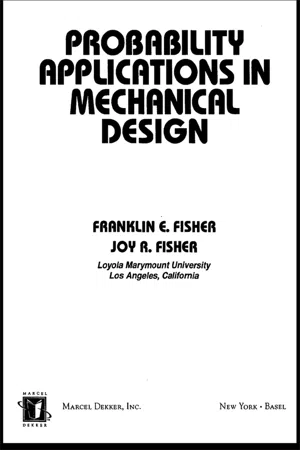
This is a test
- 304 pages
- English
- ePUB (mobile friendly)
- Available on iOS & Android
eBook - ePub
Probability Applications in Mechanical Design
Book details
Book preview
Table of contents
Citations
About This Book
The authors of this text seek to clarify mechanical fatigue and design problems by applying probability and computer analysis, and further extending the uses of probability to determine mechanical reliability and achieve optimization. The work solves examples using commercially available software. It is formatted with examples and problems for use
Frequently asked questions
At the moment all of our mobile-responsive ePub books are available to download via the app. Most of our PDFs are also available to download and we're working on making the final remaining ones downloadable now. Learn more here.
Both plans give you full access to the library and all of Perlego’s features. The only differences are the price and subscription period: With the annual plan you’ll save around 30% compared to 12 months on the monthly plan.
We are an online textbook subscription service, where you can get access to an entire online library for less than the price of a single book per month. With over 1 million books across 1000+ topics, we’ve got you covered! Learn more here.
Look out for the read-aloud symbol on your next book to see if you can listen to it. The read-aloud tool reads text aloud for you, highlighting the text as it is being read. You can pause it, speed it up and slow it down. Learn more here.
Yes, you can access Probability Applications in Mechanical Design by Franklin Fisher in PDF and/or ePUB format, as well as other popular books in Naturwissenschaften & Mechanik. We have over one million books available in our catalogue for you to explore.
Information
1
Data Reduction
Data for load carrying material properties can be modelled using any probability distribution function. Statistical goodness-of-fit tests should be applied to determine if the data set could be randomly drawn from that distribution. Modelling has progressed beyond a simple two parameter (ì,ž) Gaussian distribution. This book treats the three parameter (ä, â, ã) Weibull distribution, as well as the traditional Gaussian distribution.
Many authors relegate the subject of data reduction to an appendix at the back of the book. In the opinion of the authors, the topic deserves much more attention.
I. REDUCTION OF RAW TABULATED TEST DATA OR PUBLISHED BAR CHARTS
A computer program such as SAS (Statistical Analysis System) statistical software or other compatible software is used to fit test data to a Gaussian curve.

(1.1)
where -∞≤×≤+∞≤ with
μ-is the mean for an infinite sample size
ž-is the standard deviation for an infinite sample size.
The program also fits data to a Weibull curve,
ž-is the standard deviation for an infinite sample size.
The program also fits data to a Weibull curve,

(1.2)
where γ≤×≤+∞ and g (x)=0 when x≤γ and
δ-is a scale parameter for infinite sample size
β-is a shape parameter for infinite sample size
γ-is a threshold parameter
β-is a shape parameter for infinite sample size
γ-is a threshold parameter
The computer solves for the Weibull parameters as well as the Gaussian mean and standard deviation for a set of individual values from mechanical testing or published bar charts with more than one or two samples at a given value for the mid point of the bar (cell width).
Some computer software solves for only two Weibull parameters δ and β while γ is set to zero. The failure curves f(x) and g(x) are used to generate the reliability

(1.3)

(1.4)
The Weibull G(x), g(x) and Gaussian F(x) f(x) are unity curves with values from zero to one. The Weibull and Gaussian curves are used throughout this book except in chapter four where the constant failure-rate for reliability is introduced to explain the wear and tear on machinery. The computer calculations for Eqs. (1.1) and (1.2) allows the individual data to be sorted or listed as a bar chart. Sturges Rule [1.12, 1.16] presents an acceptable means of plotting data on linear coordinates, where, the data is grouped in cells of width w, over the range R, of the data.
- Number of cells (K)=1+3.3 log10 N where N is the number of individual data points. Grouped data from bar charts are already partitioned as presented in the data source, so the steps outlined for using Sturges Rule will not apply: however, the number of cells can be checked.
- Range (R)=maximum value minus the minimum value.
- Cell width (W)=R/K.
The number of c...
Table of contents
- COVER PAGE
- TITLE PAGE
- COPYRIGHT PAGE
- MECHANICAL ENGINEERING
- PREFACE
- LIST OF SYMBOLS
- 1: DATA REDUCTION
- 2: APPLICATION OF PROBABILITY TO MECHANICAL DESIGN
- 3: OPTIMUM DESIGN
- 4: RELIABILITY
- APPENDIX A: LINEARIZATION OF THE WEIBULL EQUATION
- APPENDIX B: MONTE CARLO CALCULATIONS
- APPENDIX C: COMPUTER OPTIMIZATION ROUTINES [3.20]
- APPENDIX D: MECHANICAL FAILURE RATES FOR NON-ELECTRONIC RELIABILITY
- APPENDIX E: STATISTICAL TABLES
- APPENDIX F: LOS ANGELES RAINFALL 1877–1997
- APPENDIX G: SOFTWARE CONSIDERATIONS